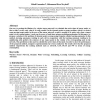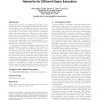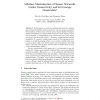346 search results - page 19 / 70 » Redundant Coverage in Wireless Sensor Networks |
WINET
2011
13 years 2 months ago
2011
Sleep scheduling, which is putting some sensor nodes into sleep mode without harming network functionality, is a common method to reduce energy consumption in dense wireless sensor...
AHSWN
2010
13 years 8 months ago
2010
One way to prolong the lifetime of a wireless sensor network is to schedule the active times of sensor nodes, so that a node is active only when it is really needed. In the dynami...
MOBIHOC
2003
ACM
14 years 7 months ago
2003
ACM
Spatial query execution is an essential functionality of a sensor network, where a query gathers sensor data within a specific geographic region. Redundancy within a sensor networ...
DCOSS
2006
Springer
13 years 11 months ago
2006
Springer
In this paper, we study the fundamental limits of a wireless sensor network's lifetime under connectivity and k-coverage constraints. We consider a wireless sensor network wit...
SECON
2008
IEEE
14 years 2 months ago
2008
IEEE
—Many sensor networks are deployed for the purpose of covering and monitoring a particular region, and detecting the object of interest in the region. In this paper, based on the...



